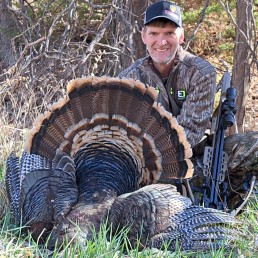Running and Gunning for Spring Gobblers
SHARE THIS POST
If everything went as expected when turkey hunting, everybody would harvest a bird. Thankfully, things do not always go as planned, and that is what makes it fun and challenging. After some birds roost the night before the hunt, I know where to be the following morning for a good chance at a bird—only to get there the next morning and realize it is not what I thought it would be when the sun came up. Maybe the bird did not fly down where you expected it. To be successful, I have learned to change at a moment’s notice, much like the Midwest weather is quick to change.
Scouting is the first thing on the list of things that makes a turkey hunter successful and puts a tag in his pocket at the end of the season. I am not sure how many times I have seen or heard a turkey far off in the distance and the only way I would have a chance at that bird was to move toward him. Without my pre-season scouting and getting to know the land I was hunting on, I would have more than likely ruined the hunt before it really got started.
Knowing the lay of the land helps me move without being detected. Deep creeks, ditches, patches of thick woods and other terrain often helps me move unseen and unheard. Also, by knowing the land, I have a good idea where I need to move to set up. And with my prior scouting, I have a good idea where the birds are moving and can often get in front of them.
I love hunting out of ground blinds, but there are times I must run-and-gun to be successful turkey hunting. I can put a blind up the night before the hunt and turkeys are not scared of it unless it is blowing haphazardly in the wind. Blinds offer protection from the weather, and I can get by with a slight movement that I would not be able to get away with if I were posted up in front of a big old tree.
For hunters who prefer the run-and-gun approach of hunting turkeys, some care needs to be taken when choosing how to dress. Camouflage has come a long way from when we were wearing Army-type camouflage clothing. Today’s camouflage comes in many patterns that blend with any terrain you might experience. Weather dictates how to dress, whether it be a cold-weather outfit, or simply a long-sleeved camouflage t-shirt and pants. Whatever the case, I always wear a facemask and gloves.
Think what part of your body does the most moving when turkey hunting. If you immediately did not think your hands, you should have. They are used when calling and getting your bow or gun into position for a shot. That is why camouflaged gloves are either the most important, or a close second to the head net of camouflage that a hunter wears.
Are you enjoying this post?
You can be among the first to get the latest info on where to go, what to use and how to use it!
When it is time for me to set up, I look for a few things. First, I search for something that will prevent my outline from being seen, such as a big tree or natural backdrop. If possible, I get on the shaded side of the cover to help prevent the sun causing a reflection off my glasses or a piece of my equipment that could get the bird’s unwanted attention.
When I do sit down, I want it to be comfortable. My turkey vest has a fold-down seat that has some cushion and keeps me from getting wet. A vest with a padded back cushion also comes in handy when sitting against a hard tree for any amount of time. An uncomfortable situation can easily be changed with a good-quality turkey vest.
Just like when I am hunting whitetails, I always carry a small folding saw to get rid of any brush or small trees that could prevent me from getting a shot off, or something I could rub up against and cause noise. Also, be sure to clean the area on the ground where you will be sitting. Shifting your legs and breaking a twig or the rustling of leaves could very well send a bird running.
No matter where you set up, the bird must want to be there. It might look perfect to you, but it is up to the bird to decide if it is a good location or not. The best advice I have is to find a spot that you believe the birds will be attracted to and stay motionless. Hopefully, the comfort of your turkey vest will allow this.
For more insight and tips on how to make the most of the time you spend hunting, check out the articles in every issue of MidWest Outdoors, available by subscribing on our website.
MWO
SHARE THIS POST
You may also like...
Nothing found.
Did you enjoy this post?
You can be among the first to get the latest info on where to go, what to use and how to use it!
Jason Houser
Jason Houser is an avid outdoorsman from Central Illinois. Houser has been a full-time freelance writer since 2008. He is also the host of Jason Houser Outdoors, airing on the Hunt Channel. He can be found on Facebook at Jason Houser Outdoors or on the web at jasonhouseroutdoors.com.
